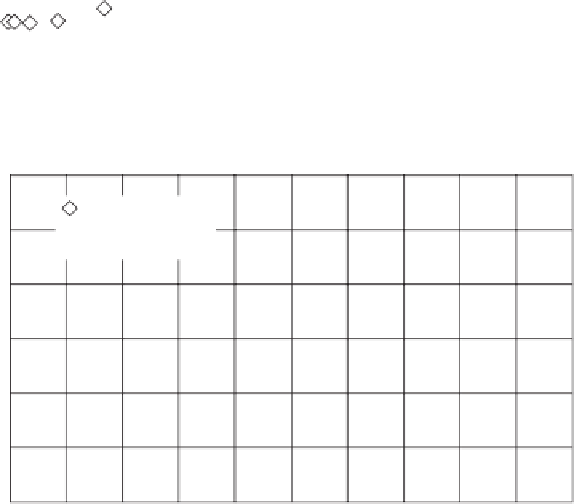Environmental Engineering Reference
In-Depth Information
0.20
NCHRP Data
0.15
0.10
0.05
0.00
0
20
40
60
80
100
120
Percent bubbling pressure
(bubbling pressure = 500 kPa)
Figure 9.23
Air diffusion rates through 5-bar ceramic disks (after Padilla et al., 2006a).
3.00
NCHRP Data
NSF Data
Average
2.50
2.00
1.50
1.00
0.50
0.00
0 0 0 0 0 0 0 0 0 0 0
Percent bubbling pressure
(bubbling pressure = 1500 kPa)
Figure 9.24
Air diffusion through 15-bar ceramic disks (after Padilla et al., 2006a).
Equations 9.79 and 9.80 show two different forms for writ-
ing the SACC equation. There is more than one way to define
the amount of air in a soil just as there was more than one
way to define the amount of water in a soil. Some soil-water
characteristic curve (SWCC) empirical equations have been
defined over the entire water content range while others have
been defined between saturated conditions and residual con-
ditions. The use of various SWCC equations is investigated
for the estimation of the air permeability function.
Numerous empirical equations have been used to describe
the SWCC (Brooks and Corey, 1964; van Genuchten 1980;
Fredlund and Xing, 1994). The Fredlund and Xing (1994)
equation for the SWCC is written as follows:
where:
a
f
,n
f
,m
f
=
fitting parameters for the SWCC,
e
=
irrational constant equal to 2.71828 for tak-
ing the natural logarithm,
ψ
=
any soil suction value, and
ψ
r
=
soil suction at residual condition.
Residual suction can vary over a wide range depending
upon the soil type. Residual suction can exceed 3000 kPa
for clay soils and be less than 100 kPa for coarse-grained
soils. The Fredlund and Xing (1994) equation uses three
fitting parameters, namely,
a
f
,n
f
, and
m
f
. Equation 9.81
can be combined with Eq. 9.80 to yield an expression for
the SACC. The SACC can be developed for both the drying
and wetting curves.
θ
s
1
ln
(
1
+
ψ/ψ
f
)
1
θ(ψ)
=
−
(ψ/a
f
)
n
f
]
m
f
(9.81)
ln
(
1
+
10
6
/ψ
r
)
{
ln[
e
+
}

























Search WWH ::

Custom Search